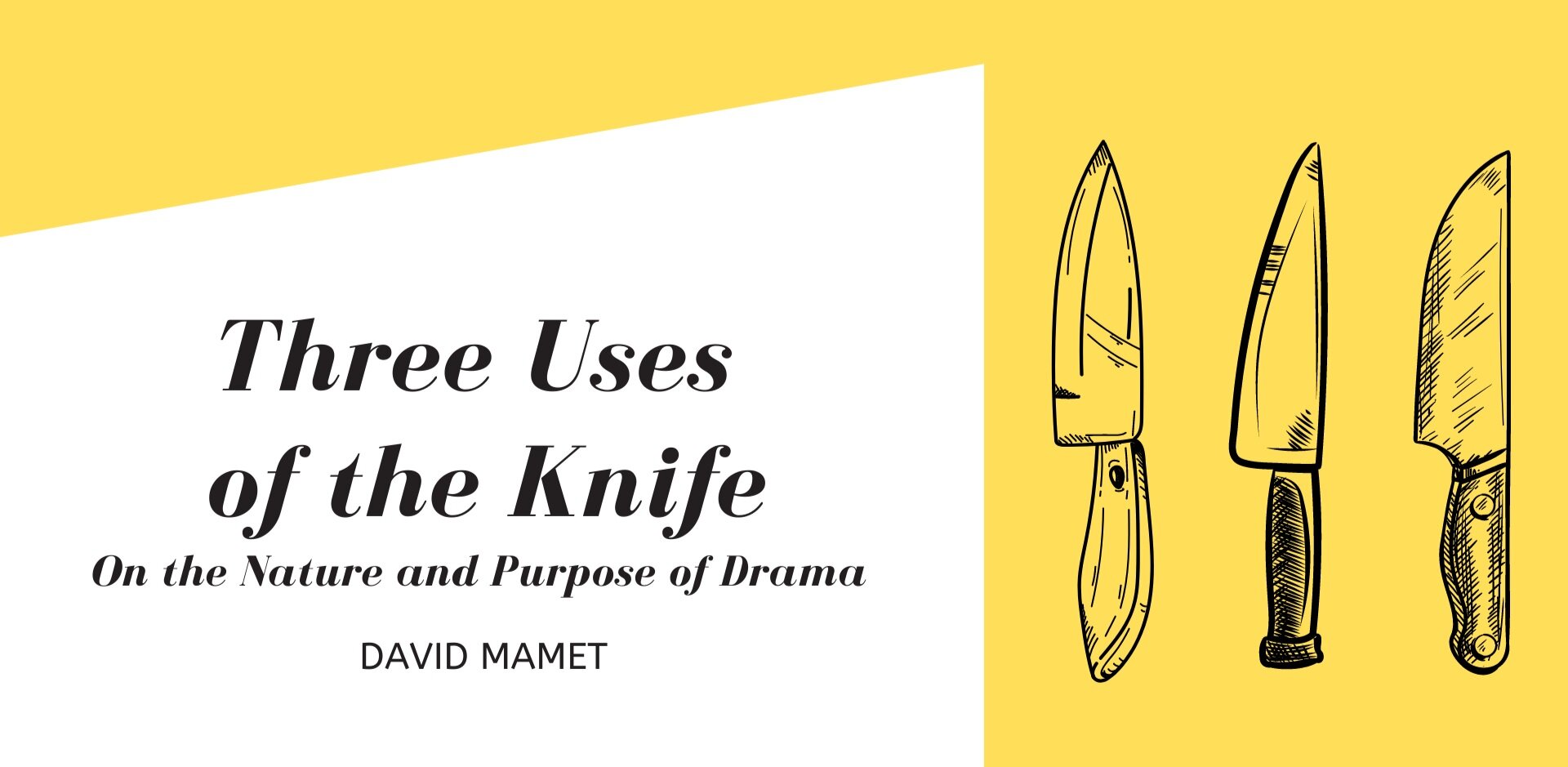Three Uses of the Knife by David Mamet (Review)
One of the first elements of story that every writer is taught is that every story has a beginning, a middle, and an end. No matter the medium, this structure continues to stand the test of time and proves that any story that deviates from this formula won’t capture the audience. What most writers are seldom taught is how to elevate their story so that it transcends the classification of distraction and becomes art. However, what exactly is art?
In Three Uses of the Knife: On the Nature and Purpose of Drama, David Mamet breaks down the three act structure and parallels it with life and human connection to drama. He examines the difference between art and distraction and explains the draw to both. Mamet challenges the creator to bring about art through their work that won’t waste the time or attention of the audience. He provides a framework for the artist to look beyond what will sell and see the necessary truth of drama. The revelation gained during the process is ultimately what is shared with viewers.
What I Liked:
This book reads like a masterclass lecture. Mamet’s tone is reminiscent of a down to Earth, honest professor that invites the reader to sit, listen, and take notes. He weaves together the fabric of the drama of life and the drama of art to show the reader how they affect one another. This provides a clarifying look at the structure of compelling narratives as opposed to writing for mass media. Mamet forces the reader to ask themselves if they want to be an artist or a distractor. The artist is the writer that creates in reaction to a perpetual inner war between their conscious and unconscious minds. The distractor is the writer that is paid to create stories that ultimately numb the mind of the viewer to allow them to forget their life for a time.
In “Part Two: Second Act Problems”, Mamet dives deep into the concept of self-censorship. He presents the idea that some potential artists rob themselves of the opportunity to fully realize their talent by self-censoring for the sake of massive success. Self-Censorship springs from the idea that in order to become successful, the writer must fit into a pre-established mold approved by a macro-organism, or their society. This is where cookie-cutter, genre stories might come from; there is no trace of art for the viewer to connect to, there is only noise to drown out the struggles of real life.
I find this idea striking and concerning all at once. It almost suggests that a true artist always needs to fall within the archetype of a starving artist in order to maintain their authentic status. Perhaps, once fame comes to the creative, the art that built their foundation for success becomes diluted by the censorship and false popularity of mass distribution. This fate is enough to strike fear into the heart of any artist fighting to maintain their authenticity. However, is niche success all there is to aspire to for true artists?
The fact that I leave this text with more questions than answers is a testament to how much Mamet challenges the reader to reconstruct their frame of mind and the way they approach narrative creation. It’s exciting and fascinating, and I recommend reading for that reason if nothing else.
Constructive Criticism:
Mamet comes across harsh, particularly when talking about storytelling mediums outside of theater. He describes television as one of the major useless distractors of all, lacking any capacity to connect with a viewer in a meaningful way. As an aspiring television writer, this threw me. However, I understand where this perception comes from because of the censored nature of television. He isn’t wrong to think that those who aspire to write for the medium are ultimately forcing themselves to fall prey to the ratings based structure. That does hamper the artistic potential of any project a TV writer hopes to get produced.
However, this book was published in 1998 and the medium has changed almost entirely. The landscape has shifted to streaming and the digital age has created pathways for artists to combat censorship. Theoretically, anyone can produce their project and present it to the world, regardless of the potential for ratings and financial success. I think a second edition touching on the evolution of all narrative mediums during the “Information Age” is worth considering. Nudge, nudge.
Famous Last Words:
David Mamet’s Three Uses of the Knife is a fascinating read that has the ability to shift the perspective of any writer, artist or distractor. Though this text primarily focuses on drama as it pertains to the stage, I think the concepts defined throughout are applicable to all mediums. That being said, readers should not allow the disdain for certain narrative styles to stop them from hearing Mamet out. Though he comes off harsh, I think it stems from a place of genuine passion for compelling storytelling.
*This book was rated on a five star scale system with five stars being the highest ranking and one star being the lowest ranking.
For more from this author: David Mamet Biography - Encyclopedia Britannica
For more from this publisher: Columbia University Press
About the Writer
Mercedes K. Milner is a WODC Co-Founder and the Writers Group Coordinator. She is a staff writer for the WODC Blog, heads the Reading on Writing column, and co-hosts two original WODC podcasts: Script to Screen Podcast and Conversations with The Write or Die Chicks. She also writes for the WODC original horror anthology podcast, A Bad Feeling Horror Podcast.


